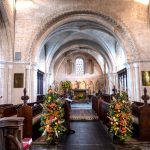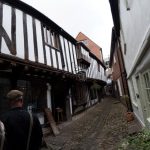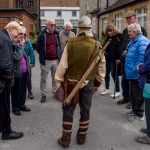Click on any image to view all


 On Friday 23rd September we were treated to a fun and interesting tour of Devizes. Our guide dressed in doubtful medieval attire pointed out the many clues to the town’s architectural heritage, some not easily apparent. The name Devizes evolved from the Latin name “Castrum ad divisas”, the castle at the boundaries. The town council turned down the opportunity to buy Devizes castle, so it is unfortunately privately owned and not open to the public. The current building is a Victorian attempt at a replica of the original castle which was dismantled in 1648 following a parliamentary order with the stone from it being used for other buildings. Part of the motte and bailey castle has survived despite being largely built over.
On Friday 23rd September we were treated to a fun and interesting tour of Devizes. Our guide dressed in doubtful medieval attire pointed out the many clues to the town’s architectural heritage, some not easily apparent. The name Devizes evolved from the Latin name “Castrum ad divisas”, the castle at the boundaries. The town council turned down the opportunity to buy Devizes castle, so it is unfortunately privately owned and not open to the public. The current building is a Victorian attempt at a replica of the original castle which was dismantled in 1648 following a parliamentary order with the stone from it being used for other buildings. Part of the motte and bailey castle has survived despite being largely built over.


 The castle saw action in two civil wars. The first less known between Empress Matilda and King Stephen in 1130 and the second between the Royalists and Parliamentarians in the 17th century. Devises has more than 400 listed and protected buildings and our guide pointed out
The castle saw action in two civil wars. The first less known between Empress Matilda and King Stephen in 1130 and the second between the Royalists and Parliamentarians in the 17th century. Devises has more than 400 listed and protected buildings and our guide pointed out
some of the many having ancient timber frame structures dating back 500 years or more. Naturally an ancient town like Devises has many legends, some of which were relayed to us with gusto by our guide. Following our tour of the town, which included a quick look inside the church with Norman origins we had lunch and then met at the Wiltshire Museum.
The museum is home to the best Bronze Age Collection in Britain and includes finds from around Stonehenge including the famous Bush Barrow gold. Ten galleries chronicle the history of Wiltshire over 500,000 years.
A temporary exhibition which attempted to relate the local landscape to the works of Thomas Hardy was interesting but did not live up to the promotional hype. We also felt the Stonehenge gold could have been exhibited better. However, despite these small criticisms the museum is well worth a visit. We had a very interesting afternoon there.
A big thank you to John Hawkes for taking and supplying the photographs for this trip.
Prepared by: John Alchin
